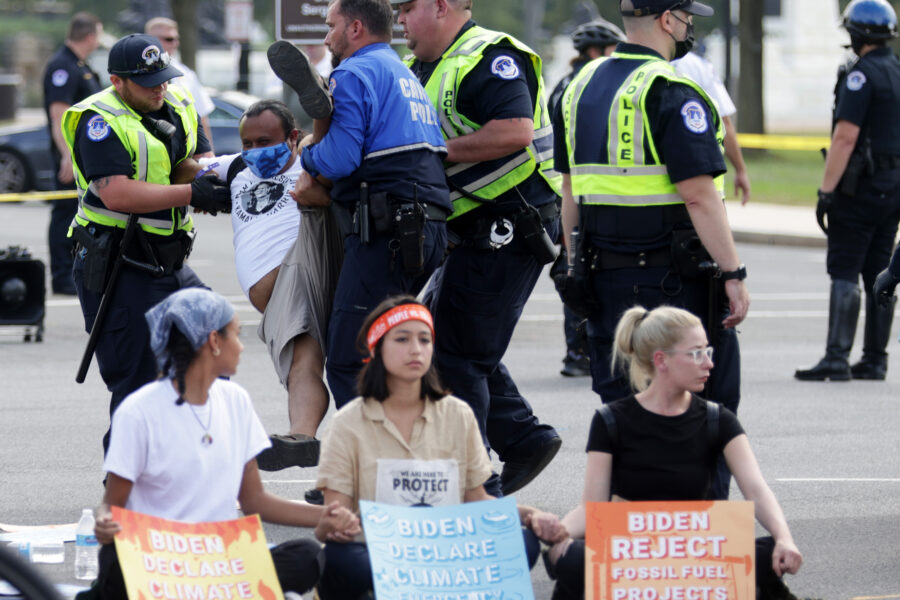Q&A: Extreme Heat, Severe Storms Among Key Climate Challenges for Maryland’s New Chief Resilience Officer
The Maryland General Assembly passed legislation in its 2022 session establishing an Office of Resilience to be set up within the Maryland Department of Emergency Management (MDEM)—a peripheral agency dealing mostly with terrorism, safety and homeland security issues.
The legislation was sponsored by Sen. Katie Hester (D-Howard County) who said at the time that seeing Ellicott City’s downtown area devastated by floods in 2016 and 2018 moved her to push for the legislation.
The bill, which went into effect in October 2022, created the position of a chief resilience officer (CRO) to be appointed by the director of MDEM, and mandated coordinating statewide efforts to meet the challenges brought on by climate change and natural disasters.
In November, Maryland Gov. Wes Moore appointed Mike Hinson as the state’s first chief resilience officer. Hinson worked with Howard Country’s emergency management office when Ellicott City experienced the floods and was involved in recovery efforts. The CRO position is one of just seven similar jobs nationwide.
We’re hiring!
Please take a look at the new openings in our newsroom.
See jobs“Hinson will focus on developing a comprehensive, multidisciplinary resilience strategy for the state to adapt, mitigate, and recover from all hazards and emergencies,” Moore’s office said while announcing the appointment.
“Hinson will work within the Maryland Department of Emergency Management to provide statewide coordination for resilience across all hazards, ensuring that Maryland can adapt to changing conditions and prepare for, withstand, and rapidly recover from disruptions to everyday life.”
Born and raised in Prince George’s County, Hinson spent his middle and high school years in Montgomery County. He worked for more than 10 years with the Howard County Office of Emergency Management in various positions, including more than three years as director.
Four months into his new position, Hinson sat down with Inside Climate News to talk about his plans for the position. This interview has been edited for clarity and length.
What are the most immediate resilience challenges for Maryland, in your opinion?
Climate issues. And not just increasing frequency of severe storms, which are very well documented, especially in this region. One case study is Ellicott City, which experienced flooding in 2016 and then in 2018. But if you look around our region in general, we have flooding going on in Annapolis on a regular basis. The same with Fredericksburg, Virginia. In general, this entire area has seen an increased amount of flooding over the years.
When I first started working in the Howard County Office of Emergency Management, it was pretty rare to have a flash flood advisory. By 2019 and 2020, we went to nearly two dozen flooding events a year, which is quite an uptick from three or four a year. And then we’re seeing some real increases in temperature. And this is worrisome because challenges from extreme heat are very serious, particularly for vulnerable communities. Both the storm severities and extreme heat are of specific concern to me going forward.

What experience do you bring to your new job as Maryland’s first chief resilience officer?
Previously, I served as director of emergency management for Howard County, where I held several positions prior to that. So, over a decade of working through emergency management systems and operations. Unfortunately, the Ellicott City floods in 2016 and then in 2018 happened in my own jurisdiction, which led to hands-on experience of being the home jurisdiction for a presidentially declared disaster. A good deal of my work involved running the emergency operations center, which required coordinating and deploying resources during both of those floods. That’s what led me down this road and at some point I got my certified climate change professional certification. I did my best to link the two streams of emergency management and climate change together because it’s something that we in the emergency management profession are going to be facing more and more as time goes by.
What does resilience mean for Maryland?
We are currently at the very end of the process of determining how we’re going to define resilience for Maryland differently from what it means at the federal level. Most states that have an office of resilience or a chief resilience officer define it differently. I’m in the process of meeting with the secretaries of various state agencies to go over the process and tease out the outcomes we would like to focus on. There’s a lot of different pieces that we need to make sure are covered under the resilience framework including food systems, environmental systems, economic systems, housing systems and so forth.
What happens once that language is sorted out?
The next step is implementing a work plan, which is also being discussed with our key partners and stakeholders. If you look at the legislation around the creation of the office and the position of chief resilience officer (CRO), it’s really talking about bringing different agencies together to make sure that we are working toward a coherent strategy. That’s why we’re meeting with various state agencies and their secretaries to make sure they’re on board with the work plan through 2025. Our next step is to really start implementing it as soon as it’s approved. And the other tier one priority from the legislation is to come up with a statewide resilience strategy. That is going to be our main focus in year one. Having spoken to my counterparts in seven other states, I believe it could take anywhere between 18 to 36 months. We’re hoping to be on the shorter end of that timeline.
Who else is on your team or are you a part of an existing team?
I have three other positions to assist the Office of Resilience. We have a food resilience coordinator position for the Food Systems Resilience Council. Then we have a resilience planning position and a deputy CRO position. I expect all of these vacancies to be filled in April. It’s a small team and we will be working pretty much on everything. Right now, we are based within the Maryland Department of Emergency Management, which is a great place for us to be. Secretary Russell Strickland has been great to work with and very supportive of our goals.
Can you give us a sense of what resilience-related projects or programs are currently underway in Maryland?
One thing I’m inheriting right off the bat would be the Food Systems Resilience Council. It’s a 19-person council that was born out of COVID-19 pandemic and focuses on food access and insecurity by looking at the entirety of the food supply chain. We act as a support mechanism for the council, which is now evolving beyond its pandemic mandate.
There’s a lot happening that the Maryland Department of Natural Resources (DNR) such as shoreline and coastal resilience work, desalination projects and similarly the Maryland Department of the Environment (MDE) also has a lot of going on. That being said, one of the first things happening within the Office of Resilience is inventory of all those projects. There’s so much going on right now that could be considered resilience projects. For us to have a broad statewide resilience strategy, it is important to have an inventory of projects. It’s really about information sharing and communication.
Do you feel you have the support structure to accomplish what you’re setting out to do?
We’ve got some experienced people in the Maryland Department of Emergency Management who have worked in the resilience space quite a bit because MDEM deals with hazard mitigation and disaster risk reduction. They have worked with me through the initial steps on our work plan. And basing us at MDEM was the best decision because it is led by a secretary-level position who reports directly to the governor and has the necessary resources at its disposal. It’s important for us to be up and running quickly and then having a direct line to the administration to make sure that we’re able to move Maryland forward on resilience.
You’re a political appointee. How long would your position continue?
As long as Secretary Strickland and Gov. Moore would like me to. Having worked in government before, it can be a mixed bag sometimes of how you’re received when you’re in a new setup or in a new position. It’s been very positive. And it gives me a lot of hope that we can make some big moves.
Share this article
Disclaimer: The copyright of this article belongs to the original author. Reposting this article is solely for the purpose of information dissemination and does not constitute any investment advice. If there is any infringement, please contact us immediately. We will make corrections or deletions as necessary. Thank you.







